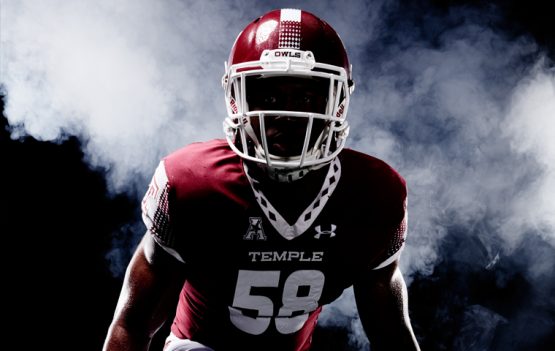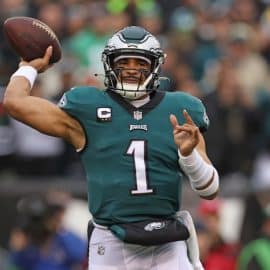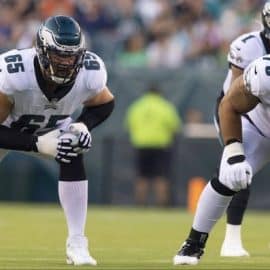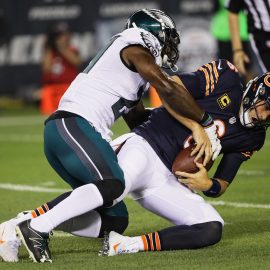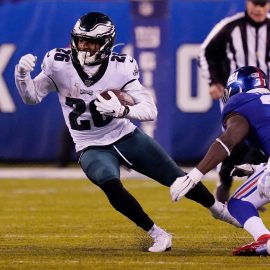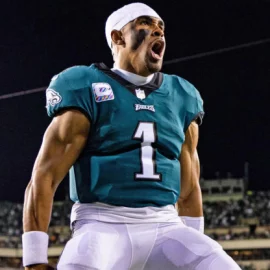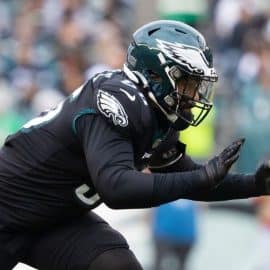It’s all about the terminology.. we’ve all heard that before… but it’s especially true regarding any new team member in an NFL organization…
As if the terminology and demands of the massive playbooks aren’t enough, the outdated references to pop culture by well-meaning special teams coordinator Bobby April assure the players attending Eagles rookie camp at the NovaCare Complex this weekend will be in for a head-spinning experience all the way to the end.
April blurted out a comparison to 1970s sitcom “Laverne and Shirley” when trying to make a point to his troops during a particularly humorous interlude highlighting the morning session.
“I had no clue, no clue what he was talking about,” admitted UDFA and former Penn State safety Drew Astorino, who was born five years after the show went off the air. “It went right over my head.”
Terminology…
There is a recurring nightmare common to the NFL quarterback. He is on the field, sweat dripping from forehead, enemies staring malevolently from just beyond the neutral zone… The quarterback motions his teammates into the huddle and informs them of the play. But something is wrong. Like 10 “Kafka” characters they stare back at him blank-faced, clueless… He speaks, but they don’t understand.
It was no dream when it happened to Wade Wilson during his first season in New Orleans. Wilson had received his NFL indoctrination from the Vikings, his employers for 11 seasons. And as he relayed the call to his new Saints teammates in 1993, he was met with the uncomprehending stares that might greet a graduate professor of particle physics who accidentally stumbles into a remedial algebra class.
“I must have been calling a Minnesota play,” says Wilson, who was at the time of the interview with the Raiders, his fifth NFL team and, by his reckoning, eighth or ninth offensive system. “Guys are looking at me like I’m crazy. We wound up calling a basic play, just to run something. Thank God it was a preseason game.”
Every new player—every free agent, every trade acquisition, every rookie— brings with him the coded vocabulary of his previous team. To be competitive, every player on the roster must be speaking the same language by the beginning of September.
In terms of complexity and rote learning, football is to other major sports what a Miles Davis composition is to “She’ll Be Coming ‘Round the Mountain.” A typical NFL offensive playbook may contain 60 to 70 plays, many of which can be run from various alignments. Each player has a specific task on every play. On the other side of the ball, the defense has numerous formations and coverage schemes of its own.
All of it must be communicated among coaches and players, and it must be done efficiently (because there are only 40 seconds between snaps), precisely (because one blown assignment is likely to doom a play) and secretively (because sometimes you have to call out audibles). The result is a highly developed system of terminology.
When a coach sends pieces of this terminology to his quarterback via radio transmitter, he delivers two basic nuggets of information: the formation—which almost always alludes to the position of the tight end, and often that of the running backs— and the play. Some codes give blocking assignments, too. The quarterback adds the snap count.
To illustrate, one of Ravens’ former head coach Ted Marchibroda’s old standbys was a play called “Split Right 26 Power O.” “Split Right” means that the backs are split, one on each side of the quarterback, and the tight end is lined up next to the right tackle. The “26” designation directs the No. 2 back (halfback) to run through the No. 6 hole (between right tackle and tight end). “Power” refers to a double-team block by the tight end and the tackle, while “O” tells the O guard (left guard) to pull through the hole. Multiply that by about 1,000 and you’ll end up with something like a league-wide lexicon–at least until someone adds a new term, which probably will be tomorrow. At least the radio headsets have simplified the situation somewhat by curtailing hand signals, the NFL version of sign language. Much of what you hear around the league today is a version of the terminology employed by the late great coach and analyst Bill Walsh during the 49ers’ dynasty of the 1980s. But Walsh’s code isn’t exactly the NFL equivalent of U.N. Esperanto. Even his most loyal proteges, such as Mike Shanahan and Mike Holmgren, add to and subtract from it in editing their playbooks. And so we are left with a confusing babble, a series of United Nations sub-sessions carried out in 65,000-seat stadiums.
“It’s like learning a whole new language every time you move teams,” says former QB and coach Jim Zorn.
Or at least a new dialect. “In general, it’s like comparing the way they speak Spanish in Spain to how they speak it in Mexico,” says former Carolina quarterback Steve Beuerlein, who had played for five NFL teams and eight coaches. “It can get confusing.”
And the confusion isn’t limited to frequent-flyer backup quarterbacks. Offensive tackle Bruce Armstrong played all of his 12 seasons in New England, but under five coaches. Wide receiver Tim Brown and guard Steve Wisniewski had labored for five coaches with the Raiders. All three have said the biggest challenge with every coaching change has been the “terminology”…
Sometimes the code changes even when the coach doesn’t. That happened to Beuerlein when Carolina switched playbooks along with offensive coordinators back in 1999. “The previous year, with Joe Pendry, we’d usually just call a number sequence—two digits—then one word, like `Denver’ or ‘Razor,’ “Beuerlein says. “In the new offense we got more words. We realized we must be more descriptive in the huddle.”
That basic distinction— words vs. numbers —divides the NFL into two major camps.
“I always felt terms were more graphic,” the late Bill Walsh said, “more connected to what we actually do. Numbers give you thousands of variables for pass patterns, but I think they’re harder to memorize.”
Marchibroda spent much of his long NFL career simplifying the terminology system he first instituted in Baltimore in 1975, and he prefers numbers. He likes that he can call “258” and the split end knows to run a 2 pattern, the tight end a 5 pattern, and the flanker an 8 pattern. And he isn’t particularly worried about recall.
“When you call a play 20 to 30 times during the course of a season–and you probably practice it hundreds of times–it becomes second nature,” Marchibroda said.
In the prose-oriented systems, certain rules of nomenclature apply.
Foremost is brevity. “Everything happens so fast during a game that the amount of words you have to repeat is critical,” Zorn says. “You have to talk in a concise manner.”
So coaches tend to employ easily distinguished, one-syllable words. “Fire,” “Tank” and “Jet” are perfect. “Lion” is acceptable. “Personal Seat License” won’t do.
It also helps if you can build in a mnemonic, a trick to help the player associate a term with its corresponding play. Marchibroda mentions two pass patterns, Sponge and Whisk, that have clues buried in the capitals. Sponge is a strongside pattern; Whisk is to the weakside. During his early years as a quarterback in Seattle, Zorn says assistant coaches Rusty Tillman and Howard Mudd were the team’s resident wordsmiths. Sometimes they formed contractions of two existing terms. Sometimes they used acronyms. For instance, if they wanted the fullback to block the “Mike” linebacker, they would use the term “Bom(b)”-for “Back On Mike”.
Another key is avoiding homonyms. “I sought terms that were starkly different from one another,” Walsh said. “You didn’t want any term that could be misinterpreted or misunderstood. For instance, `Break’ and `Rake’—they wouldn’t be any good together.”
Prior associations must be considered, too. When Lions coach Bobby Ross once hired Zorn, he asked the assistant to write up some plays. The boss had a problem with one of them, a defensive coverage scheme. To Zorn, who figures he had memorized seven terminology systems since he joined the Seahawks as a rookie in 1976, the term “safeties hanging” meant they line up shallow. To Ross, “safeties hanging” suggested they soften up, retreat a few steps. (To Mike Ditka, it probably signified Chad Cora and Rob Kelly marched to the gallows after a blown coverage, but that’s a different matter)… Zorn found a new phrase.
Coaches will negotiate with each other in such a manner. But if it’s a player who complains of being confounded, they’ll throw him a pat on the back and a playbook as thick as a Ken Starr footnoted report.
Players who move from team to team (or who welcome revolving regimes of coaches) must constantly revert to Lesson One: Basic Conversation. There are a few consistencies across the league, certainly. “Right” invariably means the tight end is lined up on the right side. “Split” or “I” always will refer to placement of the backs. Beyond that you had better consult your Berlitz NFL Phrase Book.
Coaches find themselves torn. They want to prevent overload, they really do. But they can’t help adding another handy phrase or two. Some even change the “live” word, which activates an audible, every week.
“Who’s to say someone won’t forget?” Walsh said. “He’ll be like a sentry walking on duty, muttering to himself, ‘What the hell was that password?'”
It would be easy to assume that the simplest systems are always the best. But the Broncos and Packers are doing just fine with the complicated West Coast parlance…Still, when a play-term string runs 12 to 14 words, that’s 12 to 14 opportunities to stumble–especially for those still learning. When a player does incorporate a new system, old terms tend to float in the dim pool of the subconscious, waiting to surface at the most inappropriate moments.
“I know I’ve been guilty many times,” Beuerlein said. “Once in a while I’d hear a word, and for some unknown reason it would register the offense from three or four years back. I’d go out and run what I thought I was supposed to run. I’ll get back to the sidelines, and the coach will ask, `What the heck was that?’
“And I’d say, `I just ran what you told us to run.’ “
The legendary Paul Brown, coaching in Cleveland, created a numbering system for players and holes—odd for the left of center, even for the right—that is accepted today. For years, George Halas’ Bears system of numbers and colors was the major competing model. It was used for years by the Giants, and then in Dallas, where Tom Landry unpacked it. The Halas system is nearing obsolescence now. But Sid Gillman, coaching in Los Angeles in the late ’50s and San Diego in the early ’60s, devised a language-based code that spread like Beat slang.
“Sid’s system was as complex as any in history,” said Bill Walsh. “He had a term for every pass pattern for every receiver. It took years for some people to learn.”
Walsh picked up Gillman’s vocabulary in Oakland (from Al Davis) and Brown’s numbers in Cincinnati (from Brown himself), and when he became the 49ers’ coach in 1979, he melded the two systems. Walsh’s West Coast offense has been adapted by roughly half of the NFL teams since–and so has his language.
“Recently I saw Mike Shanahan on a TV feature,” Walsh said before he died in 2007. “He called a play, and it was the exact terminology we used in San Francisco.”
Meanwhile at Eagles rookie camp, undrafted free agent Jacory Harris and third-round draft pick Nick Foles are handling all the snaps at this camp, which is designed to get them to an acceptable level of speed to join the veterans for the first full-squad minicamp, which will begin May 22.
Foles on Saturday talked about the difficulty of transitioning to the Eagles’ system from the one he was in at the University of Arizona.
“I tried to break [the playbook] down and learn the formations, learn the shifts and learn the alignments, not learning the plays first but just getting an idea of the protections,” he said. “Then you go into the concepts and understand the formations and you can start plugging the concepts in. I try to dissect it in that way and not learn the plays and the formations because … that can be overwhelming, so I try and break it down to segments.”
Mastering the offense often requires the equivalent of learning a new language, another aspect Foles covered after the first session.
“It’s different, it’s a challenge, but I’m enjoying it,” he said. “I have a lot of work, and we get to watch the film right now and see the progressions. I think it went well today and the guys did really well. We have a lot to improve on of course because it’s the first time all of us played together, but it’s exciting to be out here and it’s exciting to be an Eagle.”
Defensive tackle Fletcher Cox, their first-round draft pick out of Mississippi State, sounds like he’s been ready for this all his life.
“I’m handling it really good. Coach [defensive coordinator Chris] Wilson[at Mississippi State] did a really good job at preparing [us] for this next level, and we did a lot of things similarly,” Cox said. “We get up, have breakfast, have a special team meeting, team meeting, individual meetings and then head out to practice. I kind of have a good outlook on it to begin with.”
“… I came in here ready to compete. I really pride myself on competition and competing against the other guys.”
Linebacker Mychal Kendricks, a second-round pick, exuded similar confidence, particularly when asked again if his “undersized” height (5-11) will prevent him from being able to cover NFL tight ends:
“At the end of the day, I’m going to have to go out there and do it,” he responded. “And if I do it, I do it. If I don’t, then I’ll probably get cut. So everything is going to handle itself. That’s why I’m saying it doesn’t matter, because I’m going to try my hardest and do what I can do. Hopefully everything will take care of itself.
“So I don’t really stress about it, and I don’t think you guys should either.”
Undrafted running back Chris Polk is stressing something completely different: perfection.
“[Coming] in from college, you feel like you know everything,” Polk said. “But I’m just getting critiqued on the littlest things. I just really have to be a student of the game and perfect my craft and really accept the coaching and do whatever they ask me to do. Be the first one in and the last one to leave.”
Like Foles, the language of the play calls is the most difficult thing for Polk to grasp.
“We ran a pro-style offense that had a lot of pass protection,” he said. “It was generally the same thing… just with different wording, so I have to put the same things to different words. The hardest thing for me right now is getting the raw concepts in and also going through the checkdowns and stuff, all the different formations.”
Like I said… Terminology.
Add The Sports Daily to your Google News Feed!

